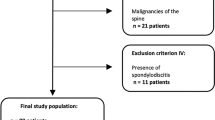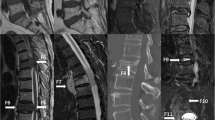Abstract
Objective
To assess the diagnostic performance of dual-energy computed tomography (DECT) with the color-coded virtual non-calcium (VNC) technique for detecting acute fractures in patients after acute spine trauma, especially in an emergency clinical setting.
Materials and methods
Our retrospective study included 31 patients presented to emergency department with suspected spine trauma. All patients underwent both DECT (80 kVp and 140 kVp) and MRI. Post-processing was performed using color-coded VNC technique. Two independent radiologists visually assessed color-coded VNC images in a random order, and one of the two readers re-assessed the images in 4 weeks after the initial assessment. They were allowed to read only color-coded VNC images and asked to determine the presence of acute fracture. To determine the standard reference point, the other two experienced radiologists made consensus readings on both grayscale CT and MRI. Sensitivity, specificity, PPV, NPV, and accuracy analyses were determined. Both intra- and inter-observer agreements were also calculated.
Results
A total of 217 vertebral bodies (65 thoracic and 152 lumbar vertebrae) were included in our study. Sensitivity was 83.3% and 76.7% for first and second readers, respectively. Specificity of 99.5% and 98.9%, PPV of 96.1% and 96.3%, NPV of 97.3% and 96.3%, and accuracy of 97.2% and 95.8%, respectively, were noted. Both intra-observer and inter-observer agreements indicated excellent agreement (κ = 0.86 and κ = 0.84, respectively).
Conclusion
In spite of the relatively low sensitivity, DECT-based detection of acute spinal fractures showed good specificity, positive predictive value, negative predictive value, accuracy, and inter-/intra-observer agreements.





Similar content being viewed by others
References
Francis RM, Baillie SP, Chuck AJ, Crook PR, Dunn N, Fordham JN, et al. Acute and long-term management of patients with vertebral fractures. QJM. 2004;97(2):63–74.
Murray N, Le M, Ebrahimzadeh O, Alharthy A, Mohammed M, Ouellette H, et al. Imaging the spine with dual-energy CT. Curr Radiol Rep. 2017;5.
Seo S, Sohn Y, Lee C, Park S, Kim H, Juhng S. Dual-energy CT for detection of traumatic bone bruises in the knee joint. J Kor Soc Radiol. 2013;69:487.
Henes FO, Groth M, Kramer H, Schaefer C, Regier M, Derlin T, et al. Detection of occult vertebral fractures by quantitative assessment of bone marrow attenuation values at MDCT. Eur J Radiol. 2014;83(1):167–72.
Kellock TT, Nicolaou S, Kim SSY, Al-Busaidi S, Louis LJ, O'Connell TW, et al. Detection of bone marrow edema in nondisplaced hip fractures: utility of a virtual noncalcium dual-energy CT application. Radiology. 2017;284(3):798–805.
Cohen J. Weighted kappa: nominal scale agreement with provision for scaled disagreement or partial credit. Psychol Bull. 1968;70(4):213–20.
Bierry G, Venkatasamy A, Kremer S, Dosch JC, Dietemann JL. Dual-energy CT in vertebral compression fractures: performance of visual and quantitative analysis for bone marrow edema demonstration with comparison to MRI. Skelet Radiol. 2014;43(4):485–92.
Petritsch B, Kosmala A, Weng AM, Krauss B, Heidemeier A, Wagner R, et al. Vertebral compression fractures: third-generation dual-energy CT for detection of bone marrow edema at visual and quantitative analyses. Radiology. 2017;284(1):161–8.
Kaup M, Wichmann JL, Scholtz JE, Beeres M, Kromen W, Albrecht MH, et al. Dual-energy CT-based display of bone marrow edema in osteoporotic vertebral compression fractures: impact on diagnostic accuracy of radiologists with varying levels of experience in correlation to MR imaging. Radiology. 2016;280(2):510–9.
Acknowledgements
This paper was supported by Wonkwang University in 2019.
Author information
Authors and Affiliations
Corresponding author
Ethics declarations
Conflict of interest
The authors declare that they have no conflict of interest.
Ethical approval
For this retrospective study formal consent was not required according to the ethical standards.
Additional information
Publisher’s note
Springer Nature remains neutral with regard to jurisdictional claims in published maps and institutional affiliations.
Rights and permissions
About this article
Cite this article
Jeong, SY., Jeon, SJ., Seol, M. et al. Diagnostic performance of dual-energy computed tomography for detection of acute spinal fractures. Skeletal Radiol 49, 1589–1595 (2020). https://doi.org/10.1007/s00256-020-03450-8
Received:
Revised:
Accepted:
Published:
Issue Date:
DOI: https://doi.org/10.1007/s00256-020-03450-8




